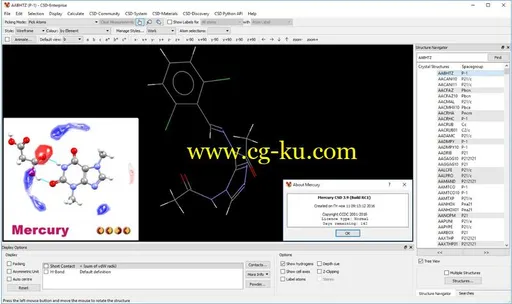剑桥结构数据库(CSD)是世界上全面和最新的完全验证的晶体结构数据库。
2017年的发行量超过了84万张,超过了55,000张!CSD含有其他地方无法提供的重要且独特的结构,被全世界的科学家使用,并为化学家提供完整的晶体结构数据库,用于处理任何有机和金属有机化合物。
剑桥晶体数据中心(CCDC, Cambridge Crystallographic Data Centre)源于剑桥大学Olga Kennard博士领导的晶体学组织的活动。
自1965年起就从事晶体数据的收集、整理与计算机化工作,该中心发展的剑桥结构数据库CSDS (The Cambridge Structural Database System,简写为CSDS)是基于X光和中子衍射实验唯一的小分子及金属有机分子晶体的结构数据库。
目前,剑桥结构数据库(CSDS)已经在世界上几乎每一个化学部门都被使用。
在大中华区,已有超过50家科研单位订购(包括中国科学院图书馆、中国科学院上海药物所、北京化工大学图书馆、南开大学图书馆、南方科技大学图书馆、南京大学图书馆、厦门大学图书馆、中山大学图书馆、汕头大学图书馆、内蒙古大学图书馆等等),该数据库体现了极高的科研价值。
多年来,CSDS一直保持不间断更新(每年增加超过50,000个结构信息),同时完善已有的结构信息。
随着网页的定期更新和访问最新出版的结构信息,订户可以掌握最新的研究信息(如图1所示)。
目前,剑桥结构数据库含有875,000多有机及金属有机化合物的X射线和中子射线衍射的分析数据;其独特的3D结构已经成为世界上众多科学家必不可少的资源。
剑桥结构数据库中的每一条信息都包括:三维结构数据:原子坐标、晶胞参数、空间群、结构精密度指标、温度与压力条件、 无序分布细节二维结构图:原子和键的性质与关联化学式和化合物名称,多肽化合物的氨基酸序列完整的文献资料,其中部分直接与电子版文献连接交叉引用立体异构体及有关重新解释和确认的详情其它已发表的与该分子有关的信息:化合物来源、结晶条件、结对构型的确定实验、 多晶型现象(同质多像)及生物活性应用范围:搜索、显示晶体结构分析分子参数研究构象取向搜索药效团模型检测分子内和分子间相互作用快捷地提取与分析分子的几何结构预测分子间相互作用确认特定官能团间相互作用的模式检索相似的晶胞堆积特性计算晶胞堆积相似度等Cambridge Structural Database 2017 |Win 6.36 Gb / MacOsx 6.41 Gb / Linux32 8.02 Gb / Linu x64 8.06 GbCambridge Crystallographic Data Centre (CCDC) has released Cambridge Structural Database (CSD) 2017.
This release, with news of data additions, new functionality and underlying improvements.
The Cambridge Structural Database 2017 - What’s new:The Cambridge Structural Database (CSD) is the world’s comprehensive and up-to-date database of fully validated crystal structures.
The 2017 release contains over 840,000 entries – an impressive increase of more than 55,000 entries! Containing important and unique structures not available anywhere else, the CSD is used by scientists worldwide and provides the complete crystal structure database for chemists working with any organic and metal-organic compounds.
The 2017 release contains targeted enhancements to a record-breaking 73,985 existing CSD entries, including:- Enrichment of pharmaceutical structures, including addition of DrugBank IDs.
- Addition of validated metal oxidation states to over 21,000 entries.
- Inclusion of article DOIs for many older entries.
- Manual addition of structures from non-electronic data.
- Enhancement of many entries from 35 years of historical structures.
The CSD-System brings you essential crystallographic and structural chemistry capabilities to deliver knowledge from the CSD: powerful 2D/3D search, extensive geometry and interaction analysis, high impact graphics, as well as connectivity via the CSD Python API.
The exciting new CSD Python API has been improved for usability including:- Seamless installation of the CSD Python API within the CSD 2017 release.
- An upgraded CSD Python API menu in Mercury with even more scripts.
Enhancements to Mercury and ConQuest including the ability to:- Make use of touch-screens with Mercury for pinch, pan and zoom.
- Sketch a molecule within Mercury and convert to a 3D model.
- Perform additional crystallographic transformations in Mercury (such as inversion, switching space group settings or changing origin choice).
- Utilise two new metal-organic framework (MOF) subsets within ConQuest.
CSD-Discovery provides in one place all the tools you need for discovering new molecules.
Our focus on quality and usability continues through improvements in our leading docking software GOLD including the ability to:- Make the most of your unlimited processes with streamlined licensing on clusters.
- Automate and integrate preferred workflows with our first implementation of GOLD in the CSD Python API.
- Receive faster more robust development of GOLD in the future as a result of extensive updates to the underlying code.
No protein structure? No problem! To complement the structure-based virtual screening capabilities of GOLD, CSD-Discovery now includes a complete ligand-based workflow allowing you to:- Produce experimentally realistic ensembles of conformers using our CSD-driven Conformer Generator.
- Generate your pharmacophore from known binders using the improved Ligand Overlay application.
- Screen your virtual library using the Field-Based Ligand Screener in the CSD Python API.
Key to usability is, of course, education, so watch out for a series of new GOLD tutorials, in line with other new videos covering many application areas of the CSD-Enterprise family.
CSD-Materials helps you explore exciting new materials through analysing intra- and intermolecular interactions within the lattice, allowing you to understand your material’s behaviour and refine its properties.
In line with our quality and usability push, we’ve made a number of improvements based on work with our Crystal Form Consortium including:- Enhancements to the graphical user interface for studying crystal packing similarity and dissimilarity.
- Significant advances in the layout and usability of the Hydrogen Bond Propensity application.
About Cambridge Structural Database (CSD).
Established in 1965, the CSD is the world’s repository for small-molecule organic and metal-organic crystal structures.
Containing over 900,000 entries from x-ray and neutron diffraction analyses, this unique database of accurate 3D structures has become an essential resource to scientists around the world.
With comprehensive and fully retrospective coverage of the published literature you can have full confidence that your CSD searches are returning all crystal structure matches.
The CSD also contains data published directly through the CSD as CSD Communications that are not available anywhere else.
Each crystal structure undergoes extensive validation and cross-checking by expert chemists and crystallographers to ensure that the CSD is maintained to the highest possible standards.
Every entry is enriched with bibliographic, chemical and physical property information, adding further value to the raw structural data.
These editorial processes are vital for enabling scientists to interpret structures in a chemically meaningful way.
The CSD is continually updated with new structures (>50,000 new structures each year) and with improvements to existing entries.
With regular web-updates and early online access to newly published structures you can keep fully informed of the latest research.
About Cambridge Crystallographic Data Centre (CCDC).
The Cambridge Crystallographic Data Centre (CCDC) is the home of small molecule crystallography data and is a leader in software for pharmaceutical discovery, materials development, research and education.
The CCDC compiles and distributes the Cambridge Structural Database (CSD), the world's repository of experimentally determined organic and metal-organic crystal structures.
We also produce associated knowledge-based application software for the global community of structural chemists, delivered through the CSD-System, CSD-Discovery, CSD-Materials and CSD-Enterprise.
Product:Cambridge Structural Database (CSD)Version:2017Supported Architectures:32bit / 64bitLanguage:englishSystem Requirements:Win / MacOsx / LinuxSupported Operating Systems:Windows XP or newerSize: Win 6.36 Gb / MacOsx 6.41 Gb / Linux32 8.02 Gb / Linu x64 8.06 Gb


发布日期: 2017-11-10